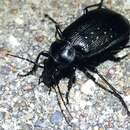fi
nimet breadcrumb-navigoinnissa


Calosoma sayi, also known as "Say's caterpillar hunter or "Black Caterpillar Hunter",[1] [2] is a species of ground beetle of the subfamily Carabinae.[3] It was described by Pierre François Marie Auguste Dejean in 1826.[3] A large, lustrous black beetle found throughout the United States, its habitat is fields and disturbed areas. About 25mm to 28mm long, its grooved elytra have rows of metallic dots or pits. Said pits are smaller than many Calosoma, and are ruby red. Both larvae and adults prey upon other larvae and pupae, specifically those of grubs, flies, and lepidoptera.[2]
This black caterpillar hunter beetle[4] (Calosoma sayi) was found in Milledgeville, Ga. on August 30th, 2022 in a parking lot. It was first identified by Pierre François Marie Auguste Dejean in 1826.
 Calosoma sayi
Calosoma sayi Calosoma sayi, also known as "Say's caterpillar hunter or "Black Caterpillar Hunter", is a species of ground beetle of the subfamily Carabinae. It was described by Pierre François Marie Auguste Dejean in 1826. A large, lustrous black beetle found throughout the United States, its habitat is fields and disturbed areas. About 25mm to 28mm long, its grooved elytra have rows of metallic dots or pits. Said pits are smaller than many Calosoma, and are ruby red. Both larvae and adults prey upon other larvae and pupae, specifically those of grubs, flies, and lepidoptera.
This black caterpillar hunter beetle (Calosoma sayi) was found in Milledgeville, Ga. on August 30th, 2022 in a parking lot. It was first identified by Pierre François Marie Auguste Dejean in 1826.
Calosoma sayi es una especie de escarabajo del género Calosoma, familia Carabidae. Fue descrita científicamente por Dejean en 1826.[1]
Esta especie se encuentra en los Estados Unidos, México, La Española y Cuba.[1]
Es una especie de escarabajo terrestre de la subfamilia Carabinae. Es un gran escarabajo negro lustroso. Su hábitat son los campos y las áreas alteradas y mide aproximadamente de 25 a 28 mm de largo, sus élitros ranurados tienen filas de puntos metálicos. Las larvas y los adultos se alimentan de otras larvas y pupas, específicamente de moscas y lepidópteros.[2]
Calosoma sayi es una especie de escarabajo del género Calosoma, familia Carabidae. Fue descrita científicamente por Dejean en 1826.
Esta especie se encuentra en los Estados Unidos, México, La Española y Cuba.
Es una especie de escarabajo terrestre de la subfamilia Carabinae. Es un gran escarabajo negro lustroso. Su hábitat son los campos y las áreas alteradas y mide aproximadamente de 25 a 28 mm de largo, sus élitros ranurados tienen filas de puntos metálicos. Las larvas y los adultos se alimentan de otras larvas y pupas, específicamente de moscas y lepidópteros.
Calosoma sayi is een keversoort uit de familie van de loopkevers (Carabidae).[1] De wetenschappelijke naam van de soort is voor het eerst geldig gepubliceerd in 1826 door Dejean.
Bronnen, noten en/of referenties